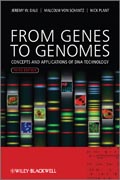
From genes to genomes: concepts and applications of DNA technology
Dale, Jeremy W.
Schantz, Malcolm von
Plant, Nicholas
The latest edition of this highly successful textbook introduces the key techniques and concepts involved in cloning genes and in studying their expressionand variation. The new edition features: Increased coverage of whole-genome sequencing technologies and enhanced treatment of bioinformatics. Clear, two-colour diagrams throughout. A dedicated website including all figures. Noted forits outstanding balance between clarity of coverage and level of detail, thisbook provides an excellent introduction to the fast moving world of moleculargenetics. INDICE: Preface xiii 1 From Genes to Genomes 1 1.1 Introduction 1 1.2 Basic molecular biology 4 1.2.1 The DNA backbone 4 1.2.2 The base pairs 6 1.2.3 RNA structure 10 1.2.4 Nucleic acid synthesis 11 1.2.5 Coiling and supercoilin 11 1.3 What is a gene? 13 1.4 Information flow: gene expression 15 1.4.1 Transcription 16 1.4.2 Translation 19 1.5 Gene structure and organisation 20 1.5.1 Operons 20 1.5.2 Exons and introns 21 1.6 Refinements of the model 22 2 How to Clone a Gene 25 2.1 What is cloning? 25 2.2 Overview of the procedures 26 2.3 Extraction and purification of nucleic acids 29 2.3.1 Breaking up cells and tissues 29 2.3.2 Alkaline denaturation 31 2.3.3 Column purification 31 2.4 Detection and quantitation of nucleic acids 32 2.5 Gel electrophoresis 33 2.5.1 Analytical gel electrophoresis 33 2.5.2 Preparative gel electrophoresis 36 2.6 Restriction endonucleases 36 2.6.1 Specificity 37 2.6.2 Sticky and blunt ends 402.7 Ligation 42 2.7.1 Optimising ligation conditions 44 2.7.2 Preventing unwanted ligation: alkaline phosphatase and double digests 46 2.7.3 Other ways of joining DNA fragments 48 2.8 Modification of restriction fragment ends 49 2.8.1 Linkers and adaptors 50 2.8.2 Homopolymer tailing 52 2.9 Plasmid vectors 53 2.9.1 Plasmid replication 54 2.9.2 Cloning sites 55 2.9.3 Selectable markers 57 2.9.4 Insertional inactivation 58 2.9.5 Transformation 59 2.10 Vectors basedon the lambda bacteriophage 61 2.10.1 Lambda biology 61 2.10.2 In vitro packaging 65 2.10.3 Insertion vectors 66 2.10.4 Replacement vectors 68 2.11 Cosmids71 2.12 Supervectors: YACs and BACs 72 2.13 Summary 73 3 Genomic and cDNA Libraries 75 3.1 Genomic libraries 77 3.1.1 Partial digests 77 3.1.2 Choice of vectors 80 3.1.3 Construction and evaluation of a genomic library 83 3.2 Growingand storing libraries 86 3.3 cDNA libraries 87 3.3.1 Isolation of mRNA 88 3.3.2 cDNA synthesis 89 3.3.3 Bacterial cDNA 93 3.4 Screening libraries with geneprobes 94 3.4.1 Hybridization 94 3.4.2 Labelling probes 98 3.4.3 Steps in a hybridization experiment 99 3.4.4 Screening procedure 100 3.4.5 Probe selectionand generation 101 3.5 Screening expression libraries with antibodies 103 3.6Characterization of plasmid clones 106 3.6.1 Southern blots 107 3.6.2 PCR andsequence analysis 108 4 Polymerase Chain Reaction (PCR) 109 4.1 The PCR reaction 110 4.2 PCR in practice 114 4.2.1 Optimisation of the PCR reaction 114 4.2.2 Primer design 115 4.2.3 Analysis of PCR products 117 4.2.4 Contamination 118 4.3 Cloning PCR products 119 4.4 Long-range PCR 121 4.5 Reverse-transcription PCR 123 4.6 Quantitative and real-time PCR 123 4.6.1 SYBR Green 123 4.6.2 TaqMan 125 4.6.3 Molecular beacons 125 4.7 Applications of PCR 127 4.7.1 Probes and other modified products 127 4.7.2 PCR cloning strategies 128 4.7.3 Analysis of recombinant clones a
- ISBN: 978-0-470-68385-9
- Editorial: John Wiley & Sons
- Encuadernacion: Rústica
- Páginas: 400
- Fecha Publicación: 25/11/2011
- Nº Volúmenes: 1
- Idioma: Inglés
